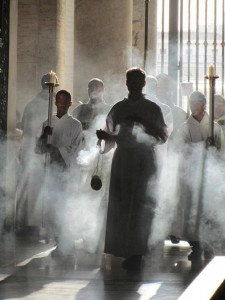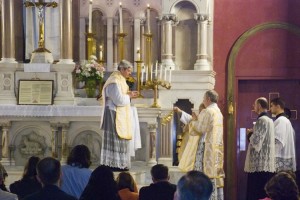The Catholic use of incense
 Catholics in many places these days dislike the use of incense. Most often it is a knee-jerk reaction to smell or other perceived “toxins” in the air. In fact, there are no toxins released. At the sight of a cold thurible loud coughing and carrying-on ensues. All the noise is, I suppose, is a passive aggressive way of telling the priest to put the thurible away. But laity (and some clergy) may be unaware of the reasons we use in incense in the worship of God.
Catholics in many places these days dislike the use of incense. Most often it is a knee-jerk reaction to smell or other perceived “toxins” in the air. In fact, there are no toxins released. At the sight of a cold thurible loud coughing and carrying-on ensues. All the noise is, I suppose, is a passive aggressive way of telling the priest to put the thurible away. But laity (and some clergy) may be unaware of the reasons we use in incense in the worship of God.
I do not doubt for a second that some people have breathing issues. Asthma, COPD, lung cancer, etc are a regular diagnosis for some people. I have a friend who gives me the evil eye when she sees the smoke coming down the aisle. In one parish I heard someone saying that the use of incense there is only used for funerals. And I know that priests and servers have yet to find reasonable solutions in using incense. One safe way not to get into fighting match is to remove the smoking thurible from the sanctuary after it is used and bring it back when it is next needed.
Why is it that Catholics use incense?
The history of using incense in worship is long. Some scholars point to the ancient world of the Assyrians, the Babylonians and the Egyptians, to ward off demons. At least this is one theory. The Israelites burned incense in Temple rituals, with their offerings of oil, grain, fruits and wine (Numbers 7:13-17). We also read in Torah that Moses erected an altar for the burning of incense at the entrance to the meeting tent where the Ark of the Covenant dwelled (Exodus 30:1-10).
Psalm 141 sings: “Let my prayer be counted as incense before thee, and the lifting up of my hands as an evening sacrifice!”
The minor prophet Malachi tells his people
From the farthest east to the farthest west, my name is honored among the nations and everywhere a sacrifice of incense is offered to my name, and a pure offering too, since my name is honored among the nations (1:11).
In the Book of Revelation, John writes that incense is used in the heavenly worship before the throne of God:
Another angel came in holding a censer of gold. He took his place at the altar of incense and was given large amounts of incense to deposit on the altar of gold in front of the throne, together with the prayers of all God’s holy ones. From the angel’s hand, the smoke of the incense went up before God, and with it the prayers of God’s people.
 Hence, aromatic smoke signifies our prayers, which rise to heaven and to the ear of God. I happen to use different scents for different occasions: Mass at Christmas is not the same as at Easter or a funeral Mass or a Benediction rite.
Hence, aromatic smoke signifies our prayers, which rise to heaven and to the ear of God. I happen to use different scents for different occasions: Mass at Christmas is not the same as at Easter or a funeral Mass or a Benediction rite.
Liturgical historians tells us that the Church’s use of incense had very clear points in history that incense was introduced and for what reasons; often it began when the bishop offered Mass and later use was extended to Mass offered by the priest. The Catholic use of incense is governed by the General Instruction of the Roman Missal (GIRM). The particular times when incense may be used during the Mass:
- at the entrance procession;
- at the beginning of Mass, to incense the altar;
- at the procession and proclamation of the Gospel;
- at the offertory, to incense the offerings, altar, priest and people;
- at the elevation of the sacred Host and chalice of Precious Blood at the time of consecration.
If used at at the entrance procession and then at the preparation of the altar, the priest is directed to incense the Crucifix and/or the Paschal Candle (during Eastertide). At the Mass of Christian Burial, the priest incenses the casket as a sign of blessing, purification, prayer rising to God and of honoring the deceased. This final point, honoring the deceased, reinforces Catholic teaching that the person has certain dignity.
And if the Lauds and Vespers is prayed in a solemn manner, incense is used at the singing of the Benedictus and Magnificat. One last time you will smell incense used is at the Rite of Benediction of the Blessed Sacrament.
The gesture of incensing is a venerable and stable tradition of religion; it is a gesture that is not arbitrary. Moreover, it is a profound symbol and it ought neither to be ejected from the Liturgy nor from our experience of prayer. Often I would lite a small amount of incense for my personal prayer in my room because it helped me pray. It aids the sensuality of worship of the Triune God; incense engages the powerful sense of smell which ought to trigger in us a greater experience of wonder and awe; it aids one’s sense of solemnity in worship.
